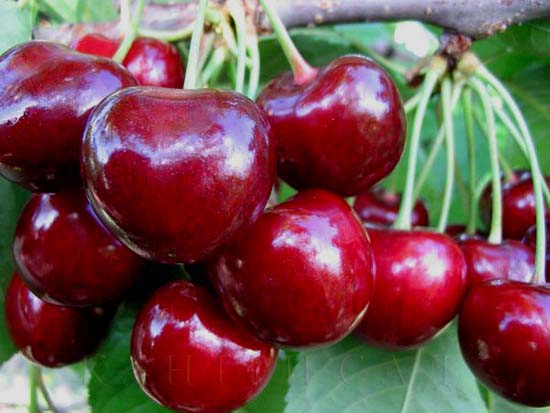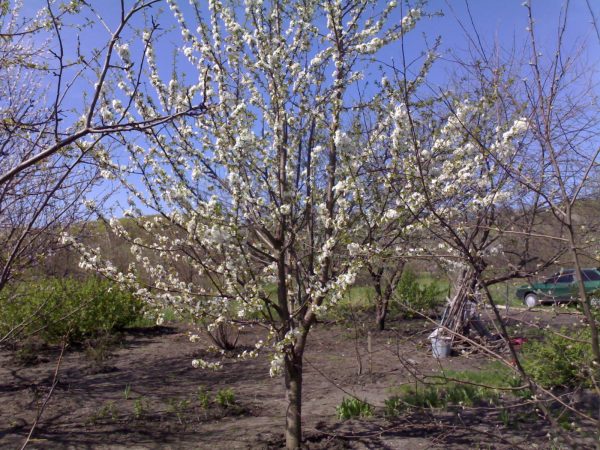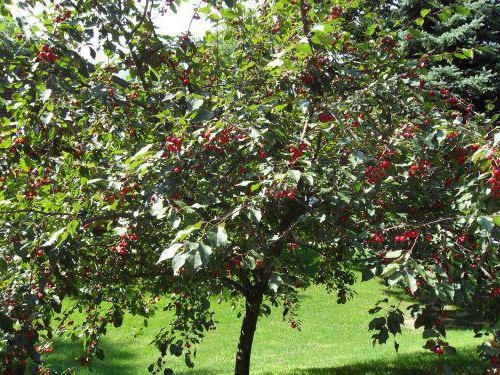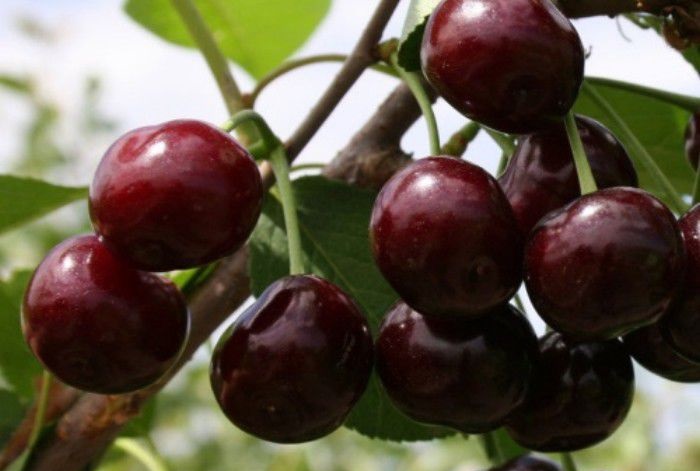The word "cherry" is associated with the hot southern sun, the Black Sea and the ancient Greek city of Kerasund. It was there that a few thousand years ago the Romans saw this plant and gave it the name Cerasus avium.
Traditional regions of the cultivation of sweet cherries lie in warm edges. More recently, it was difficult to imagine that this culture can be grown in the cold climate of Central Russia. But, as Napoleon said, "genius is the ability to distinguish the difficult from the impossible." Breeders took up the business, and Iput, a cherry, was born.
Table of contents
How southerner became northerner
It all started with the Lupine Institute in the Bryansk region. There, in the department of fruit growing, the unique geneticist Mayina Vladimirovna Kanshina has been working for more than forty years. All her talent and life she devoted to the removal of cold-resistant varieties of cherries.
Variety Iput - "daughter" of selection forms numbered 3-36 and 8-14. After their crossing, many years of cultivation and rigorous selection of hybrid seedlings followed. In 1993, a new variety of sweet cherries was entered in the register of breeding achievements and recommended for cultivation in the Central and Central Black Soil region of Russia. Name of her brainchild Mayina Vladimirovna gave the name of the river Iput, flowing through the Bryansk region.
Sweet Cherry Iput: description of the variety
Practical gardeners, thinking about acquiring a new “tenant” in their garden, are guided by several parameters: the size of an adult tree, precociousness, early ripeness, resistance to weather and other conditions, and yield. All characteristics of sweet cherry Iput for convenience are collected in the table:
| External features | Medium-sized plant. The height of an adult tree is about 3.5 meters. The crown is broad-pyramidal, densely leafy. Vegetative buds are conical, floral - rounded, ovate. The leaves are large, dark green, without pubescence. |
| Bloom | Blooms in May. Each generative bud produces a bunch of 3-4 large white flowers on long stalks. |
| Fruiting | Begins to bear fruit at the age of four or five. Crop forms on bouquet branches. The variety is declared as early, but according to reviews of gardeners in the Moscow region, it ripens not earlier than the end of June.
The color of the Iputi fruit is from red to almost black, depending on the degree of maturity. The average weight is 5.3 grams. The largest copies reach 9 grams. From the stem away easily. In rainy weather can crack. The flesh is very juicy, medium dense, scarlet, excellent sweet taste.Juice is red. Tasting score - 4.5 points. Stone separates badly. |
| Soil requirements | Neutral, loosely lumpy, not overmoistened soils. |
| Resilience | Good winter hardiness, high resistance to fungal damage. |
| Yield | From 25 to 50 kg from each tree, depending on conditions and agricultural techniques. |
| Purpose of the fruit | Universal. |
| The need for pollinators | Self-sterile grade. For pollination, Bryansk varieties Revna, Bryansk pink, Tyutchevka are well suited. |
| Transportability and curing | Whole uncracked fruits tolerate transportation well. Fresh stored for long, but not worse than other varieties. |

Thus, the advantages of the Iput variety include:
- winter hardiness;
- disease resistance;
- compactness of the tree;
- high productivity and large fruit;
- excellent taste of fruits and their universal purpose;
- good transportability and good quality for sweet cherry;
- precocity.
A few cons:
- propensity for cracking fruits;
- self-infertility;
- demanding ground.
Landing
The harvest begins with a sapling, like a theater with a hanger. Therefore, it is necessary to pick a seedling for your plot very meticulously.
- Cherries are usually planted at the age of 2 years. A two-year-old seedling should have 3-4 well-developed lateral shoots.
- If you purchase a seedling with an open root system, you need to examine it. The roots should not be rotten, dry, on the cut a healthy root has a cream color.
- The thickness of the trunk of a good sapling of sweet cherry is about 2 cm.
- The crinkleiness of the bark is a sign that the plant is over dry. Also on the trunk should not be growths, cracks, blisters.
- It is important to clarify on which stock the cherry is grafted. Practice shows that cherry cherry rootstocks have weak anchoring, and an adult tree can break at the place of fusion. The best options for rootstocks are Izmailovsky and Muscovy (hybrids of cherry and bird cherry), VTs-13 and VTs-52 (hybrid of cherry and cerapadus).
Choosing a "pet", you need to immediately wrap its roots with a moistened rag, put in a bag and tie.In this state, the seedling can be transported to the site without fear that the root system will dry out.
Sweet cherry is a light-demanding culture, and the place for it is to choose a sunny, protected from the wind. Drafts are destructive even for zoned "northerners". The soil in the area should be breathable and well drained. Swampy or clayey dense soils, lowlands with stagnation of spring thawed waters are not suitable for cherries. The horizon of the subsoil waters should lie at a depth of at least 2 meters.
In cold regions, sweet cherry can be planted only in spring. So, the preparation of the seat should be taken care of in the fall:
- dig a hole 1 meter in diameter and 80 cm deep;
- fill it with four buckets of humus, pouring it a mound.
A purchased seedling can be held for some time without disembarking on a permanent place, if you put it and sprinkle the roots with earth. And yet it is better not to pull for a long time, but to immediately place it in the landing pit.

Sweet cherry, like most fruit crops, is very convenient to plant "on a cone." The algorithm of action is as follows:
- On the mound of humus (cone), poured at the bottom of the landing pit, set the reference stake.
- Set the seedling on the top of the knoll and spread the roots so that they evenly descend along its slopes.
- Fill the pit with good soil mixed with humus and tamp the hole a little.
- Check neck position. It should be slightly above the surface.
- Tie a sapling to the support.
- Around the circumference of the planting hole make a groove and water a seedling well along this furrow.
- Mulch pristvolny circle organic mulch.
If the seedling was purchased in a container, the landing process is simplified. Enough pit 20 cm wider and deeper container volume. In it, the plant is placed together with the earthy clod and covered with a mixture of earth and humus.
Proper care
For pristvolnom circle need care throughout the life of the plant. It must be hydrated, loosened, free from weeds and mulched. On the circumference is good to plant marigolds. These flowers attract ladybirds - natural enemies of aphids,who likes to sit on the young shoots of cherries.
Immediately after the landing, the cherry must begin to form. The first thing is to examine the crown. If there is no clear “leader” among the shoots, it must be “assigned”: choose a good top one, pull it up to the support, give it a vertical position, and tie it up. The rest of the shoots - the future skeletal branches of sweet cherries. They should be shortened to the lower kidney to a length of 25 cm.
In the first year after planting, young cherries only need to be watered. In the fall, to better prepare the plant for the winter, you can set the fertilizer from superphosphate (2 tablespoons per 1 sq. M of the crown projection). The Iput variety tolerates frost well, but at a young age it is better to arrange additional protection for it.
In this capacity, nonwoven covering materials perform well. Before the onset of frost, a frame is set around the seedling and covered in several layers with agrospan or spunbond with a thickness of 60 g / sq. m
In the second year, sweet cherry will need spring nitrogen fertilization.It is better to use a good dung humus, then there is no risk to “overfeed” the plant.
Also need to continue the formation of the crown. There are different opinions about sweet cherry pruning. For example, the famous pomolog of Lev Platonovich Simirenko believed that pruning is contraindicated in this culture. Sweet cherry has a low marginalization ability, and its crown itself forms sparse. Even in mature trees, it is often possible to do with sanitary pruning and simple embossing of shoots directed inside the crown.
However, in order to stimulate fruit entry and better yields, it is necessary to teach the skeletal branches of sweet cherry to a correct position from a young age. Here the following rule applies: the greater the angle between the shoot and the trunk, the better the crop. To ensure this condition, in the old days, bast sandals were hung on the branches of young saplings. Now you can apply the method of bending shoots:

- In the spring on the side branch, closer to the top, a free loop of twine is attached.
- The second end of the string is tied to a peg in the ground so that the branch forms a straight or even obtuse angle with the trunk.
- In such a “crucified” position, the plant spends all summer. In the autumn loop can be cut.
In the middle of summer, yearlong growths are examined on the cherry tree. Cherries are capable of expelling them for a season up to 60 cm long and more. This is not too good - long increments do not have time to mature before winter. Therefore, they should pinch. Among other things, this procedure stimulates the branching of sweet cherries.
For a tree to be compact, you need to follow the height of the center conductor. Three-meter height of the leader will be enough. When it grows to this mark, it is cut with a transfer to the nearest skeletal branch.
3 facts about pollination of sweet cherries
Sweet cherry is a cross-pollinated plant. Even partially samoplodnyh varieties yield of the harvest is greatly increased if other sweet cherries are planted next to it. But this does not mean that your entire site should be turned into a cherry orchard. You can do the minimum cost.
- Sweet cherry is perfectly pollinated by its “sister” cherry. Due to this property, hybrids of these cultures appeared - dukes. Therefore, if the garden already has a cherry tree with an early ripening period, you can not plant another cherry next to Iput.As a pollinator for her, for example, Turgenevskaya cherry varieties can fit.
- Option for even more economical use of garden space - grafting donor material of a pollinator variety into the crown of the Iput blackberry. In this way, two different varieties can be obtained on one shtamba that will pollinate each other.
- If there is a suitable cherry or sweet cherry in the adjacent garden, you can completely do without your own pollinator. The main thing is to consider two points:
- plant your sweet cherry at a distance of no more than 30 meters from the neighboring tree;
- make sure that there is no pear or apple tree between them that may interfere with over-pollination.
Diseases and pests
Beachbone scourge - fungal infections. Fortunately, Iput almost does not suffer from either moniliasis or coccomycosis. If infection has occurred, you need to do the following:
- Remove and burn affected shoots as soon as possible.
- Treat the diseased plant with Chorus. This is a fungicide of extended spectrum. For better adhesion with the surface, it is possible to dissolve it not in plain water, but with the addition of household or tar soap.
About tlya, which often attacks the sweet cherry, has already been said.It is possible to fight it with chemical preparations of the “Iskra” type, but it must be remembered: insecticides kill not only pests, but also beneficial insects - bees, ladybirds, gold-eyed insects. Having noticed an aphid on my own tree, it is better to deal with it with a simple soap-and-soap solution.

Harvesting and Storage
When pouring fruit, sweet cherry must be protected from starlings. These wonderful gardeners friends can become lively competitors for a while, and in order not to remain without a crop, it is better to throw a protective net on the tree in time.
Mass cleaning cherries Iput can begin when the fruit will become dark red color. It is important to monitor the condition of the stalks: if they start to dry out, time is lost and the cherry is overripe. Such fruits will have to immediately process or eat.
It is necessary to remove cherry from the branches carefully.Do not throw, and lay the fruit in the container. Damaged, with broken skin, set aside separately.
For a long time to keep Iput fresh will not work - like any sweet cherry, it quickly loses its taste and becomes watery. You can keep it in the fridge for 5 days, but then it is better to freeze it or make preparations for the winter. A jar of fragrant jam on a winter evening will remind you of a beautiful pilgrim who has come a long way from the “Greeks” to the “Varangians”.
And finally, a short video describing cherries, including the Drozdovsky variety:
